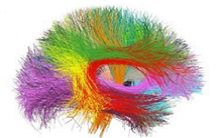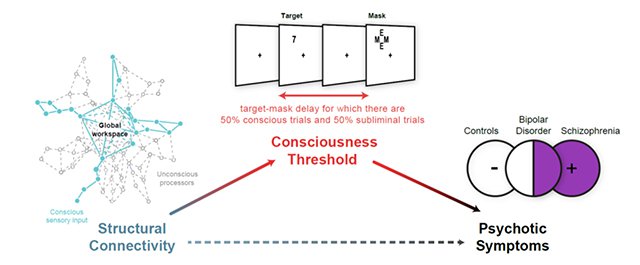Psychotic symptoms are linked with poor diffusion of information in the brain
14 January 2021
A collaborative HBP-supported study by NeuroSpin, published in the Journal of Neuroscience, shows that altered long-distance connectivity in white matter limits the brain's conscious access to information, potentially contributing to delusions and other psychotic symptoms. These findings suggest that psychosis and impaired conscious access may be closely related phenomena.

© C. Poupon/CEA
According to a theory of consciousness (global neural workspace theory), you only become conscious of something if unconscious brain activity in sensory areas spreads to a larger network of neurons throughout your brain via long-distance connectivity involving white matter.
People with schizophrenia and bipolar disorder have a deficit of conscious access and impaired long-distance connectivity. However, the relationship between these two deficits remains unclear. The aim of this study was to determine the extent to which structural connectivity is correlated with the conscious perception threshold, particularly in patients with psychotic symptoms.
To do this, the researchers included healthy adults, patients with bipolar disorder with or without psychotic symptoms, and patients with schizophrenia in their study, and used two methods: diffusion MRI tractography to study the structural connectivity of the brain, and a visual paradigm to estimate the threshold of visual conscious perception that corresponds to the minimum duration of presentation of a visual stimulus for it to reach consciousness - the shorter the stimulus, the better the conscious access.
The results obtained show that patients with psychotic symptoms (schizophrenia and bipolar disorder with psychotic features) have a higher threshold of conscious perception than controls and patients with bipolar disorder without psychotic features. For all participants, the lower the threshold, the better the long-distance white matter connectivity. These results thus confirm the global neural workspace theory that long-distance structural connectivity plays a crucial role in conscious access. In addition, the researchers show for the first time that an alteration in brain connectivity is correlated with psychotic symptoms through the elevation of the threshold of consciousness, thus providing anatomical correlates to the impairments observed in patients suffering from psychosis and suggesting that the emergence of psychotic symptoms and the deterioration of conscious access could be closely related phenomena.

Diagram representing a three-step model of the onset of psychotic symptoms: Anatomical abnormalities of cerebral connectivity lead to a rise in the threshold of consciousness, which in turn favours the emergence of psychotic symptoms. © Lucie Berkovitch/NeuroSpin
Contact at Joliot:
Josselin Houenou
josselin.houenou@inserm.fr
Original source (Dec 8): https://joliot.cea.fr/drf/joliot/en/Pages/news/Science/2020/Psychotic-symptoms-poor-information-diffusion-in-brain.aspx
See also: (Oct 29): BRICON, a project of the Human Brain Project for NeuroSpin (UNICOG)
https://joliot.cea.fr/drf/joliot/en/Pages/news/Institute/2020/BRICON-project-Human-Brain-Project-NeuroSpin.aspx
Publication:
Disruption of conscious access in psychosis is associated with altered structural brain connectivity. | J Neurosci. 2020. Lucie Berkovitch, Lucie Charles, Antoine Del Cul, Nora Hamdani, Marine Delavest, Samuel Sarrazin, Jean-François Mangin, Pamela Guevara, Ellen Ji, Marc-Antoine d'Albis, Raphaël Gaillard, Frank Bellivier, Cyril Poupon, Marion Leboyer, Ryad Tamouza, Stanislas Dehaene, Josselin Houenou



